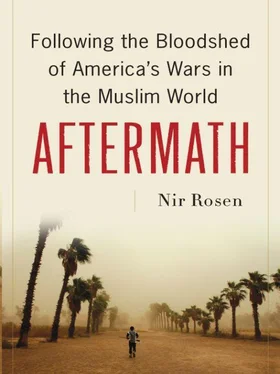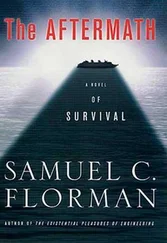The following day a group of fighters led by Abu Hureira, one of the most militant figures in Fatah al-Islam, attacked a Lebanese army location and slaughtered the soldiers. Shaker al-Absi was said to have been uninformed about this in advance and to have emerged from his home in his pajamas at the sound of fighting. Humiliated and angry, the army struck back. Abu Hureira and his followers refused to negotiate. It seems Absi was frustrated that things were getting out of control and felt that he had been forced into a battle. Rumors spread throughout the country that the soldiers had been brutally slaughtered and mutilated, provoking a wave of hatred that targeted Palestinians in general, despite the fact that Fatah al-Islam was composed mostly of non-Palestinians and all the Palestinian factions condemned it. On May 20-21 bombs exploded in a Christian and Sunni neighborhood in Beirut, igniting fears that the fighting might spread.
Shaker al-Absi claimed that he never wanted to target the Lebanese army but was forced to do so by the raid in Tripoli. In the chaos of the first day, said Muhammad al-Haj, it was not possible to establish a dialogue. Once negotiations led to a cease-fire, armed Sunni civilians from the area descended upon the camp to support the army and attack the Palestinians. Haj blames these civilians for reigniting the battle. He was shot by Fatah in a failed assassination attempt after the group grew concerned over his success in mediating between the army and Fatah al-Islam and what it meant for their role in the camp. “They thought that what was being achieved through negotiations would prevent Fatah from forming its security committee to control the camps,” he told me.
When Future Movement leader Saad al-Hariri called upon his forces to support the army and security forces, this was interpreted by his forces to mean that they should join the fight. Hundreds of armed Sunnis from the region descended upon the camp. When fighting began, it became very difficult for civilians to leave because they had to endure artillery fire as well as snipers from the army and Sunni militiamen from the north. Fatah al-Islam took advantage of the armaments of the PFLP-General Command—Ahmed Jabril’s Syrian-sponsored split from the PFLP—and the Fatah Revolutionary Council, commonly known as the Abu Nidal Organization. Members of these ostensibly secular groups—with a reputation for once performing spectacular acts of violence—were helping Fatah al-Islam out of solidarity on the local level, but not on orders from their officers. Interestingly, the Salafi leaders in the camp who had initially welcomed Fatah al-Islam disavowed them now. Dai al-Islam al-Shahal maintained contact between Fatah al-Islam and the Lebanese authorities. When the fighting started Syria closed two border points in the north.
On May 25, Hizballah leader Hassan Nasrallah gave an even-handed speech commemorating the liberation of southern Lebanon from the Israeli occupation in 2000. In that speech he discussed the clashes in the north and spoke of two “red lines.” The army and the security agencies in Lebanon were a red line that should not be crossed by attacking them. Likewise, the Palestinian civilians and their camps were a red line, and the security forces should not kill civilians in the name of a war on terror. The Future Movement seized on these statements to accuse the Shiite leader of supporting Palestinian terrorists against the army. Anger swept throughout the north and other Sunni areas in the country. At the same time Lebanese security forces cracked down on local Salafis in Tripoli, and rumors circulated that some were being tortured.
Clerics in Tripoli had to calm many of their followers who sympathized with Fatah al-Islam. Some began to feel betrayed and persecuted by the government. The Future Movement began to lose ground among Salafis. Its leaders had campaigned as protectors of Lebanon’s Sunnis but instead were perceived by some as having launched fitna (strife) in the north. In the slums of Tripoli, resentment was growing against Lebanese security forces, who were picking people off the streets even if they were innocent, beating them, and releasing them as an example to others. Some people in Tripoli felt that Fatah al-Islam members were well-intentioned mujahideen who had been forced to fight in Lebanon when they should have been fighting in Iraq. The majority of the soldiers fighting with the army against Fatah al-Islam were Sunni Muslims from northern Lebanon. Many in the north were not sure how to react. When the first few dead soldiers arrived in their hometowns for burial, some of them were not buried as martyrs because they had died fighting fellow believers. The majority of Sunnis embraced the army, however, and a propaganda campaign in support of the army began in earnest, with one bank issuing credit cards with a military camouflage motif, advertisements on television showing the nation saluting a soldier, and bumper stickers stating allegiance to the army. It was a cathartic experience after the previous year’s war and the divisions it had reinforced in the nation.
Members of the Abu Nidal Organization also provided assistance, including weapons, to Fatah al-Islam in Nahr al-Barid, and some of the Abu Nidal men who were wanted by Lebanese security forces even stayed behind and fought alongside Fatah al-Islam. Over the next three months the Lebanese army regularly announced that it had vanquished Fatah al-Islam, but despite destroying the camp and making forty thousand Palestinians homeless, the fighting continued, and Lebanese soldiers continued to die. Absi had not been seeking a confrontation with the Lebanese army, but once the fighting started he might have hoped that other supporters and Salafis would rise up throughout Lebanon and its camps. Negotiations faltered over the demand to hand over wanted Lebanese men among his ranks. Abu Salim Taha, the Fatah al-Islam spokesperson, blamed the Future Movement for inciting hatred against them. He admitted that there were many foreign Muslims among them. Even though they had no organizational ties to Al Qaeda, they considered them their brethren.
In early June it was Jund al-Sham’s turn to clash with the army, in Ayn al-Hilweh. There had been fears that the fighting in Nahr al-Barid would spread south, and now it was happening. Usbat al-Ansar, which was already part of the camp’s executive committee, played a key role in securing the camp. The Lebanese government gave Usbat al-Ansar a new status by recognizing it as a power broker and partner it could deal with. This negotiated solution allowed the Palestinians to continue policing themselves. It was a stark contrast to the military solution offered in Nahr al-Barid.
In June Lebanese security forces arrested four people in the Beqaa Valley in eastern Lebanon. They also found a large amount of explosives and money. One of the suspects was a Saudi carrying fake Iraqi identity papers. Two Syrians and a Palestinian were found with him. By then another thirty-two Fatah al-Islam prisoners had been captured, most of whom were Lebanese. The Saudi authorities asked for their citizens to be repatriated so that they could learn more about similar groups in the Kingdom, and Lebanon consented. South of Tripoli Lebanese security forces killed five Islamist fighters, at least two of whom were Saudis. In July, after Fatah al-Islam began firing missiles outside the camp, Abu Salim Taha, the Fatah al-Islam spokesman, explained that the group was targeting the army and some missiles had reached Lebanese towns because of miscalculations. He asked the Sunnis to accept his apology. Lebanon’s many Salafist jihadist groups refused to back Fatah al-Islam, as did Al Qaeda. Their focus was fighting Israel, and none of them wanted to jeopardize their position in Lebanon by provoking the authorities.
Читать дальше











